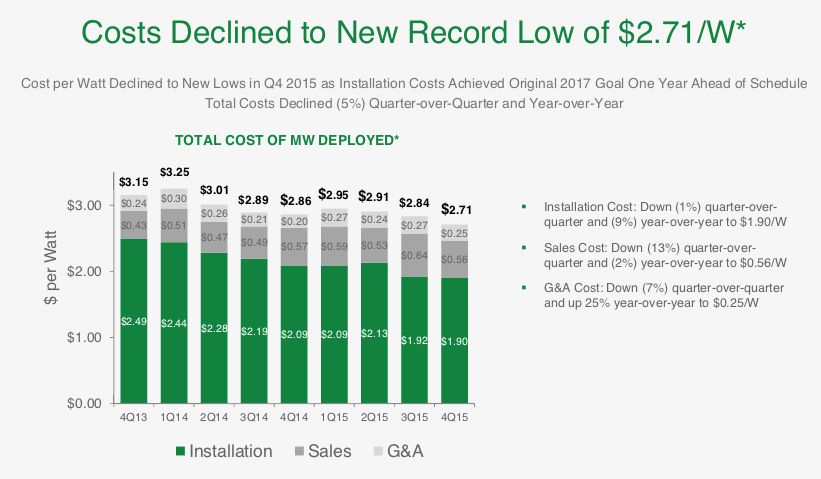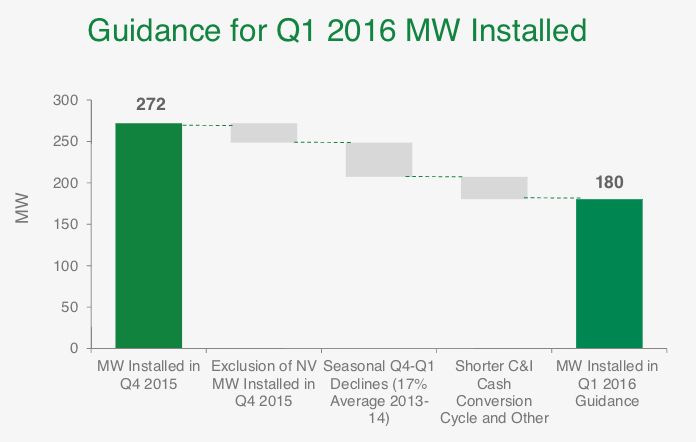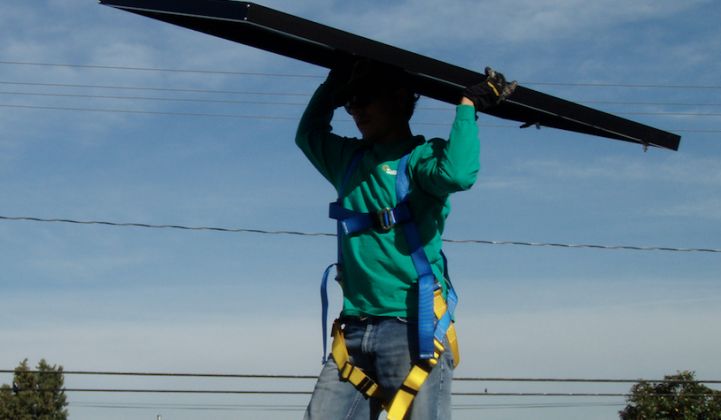SolarCity beat fourth-quarter revenue and earnings-per-share estimates, posting a still-blistering installation growth rate of 54 percent year-over-year, as announced during its quarterly earnings report.
But despite those strong numbers, the No. 1 solar financier and installer fell short of its 280-megawatt installation guidance by 8 megawatts and posted a soft Q1 guidance of 180 megawatts installed.
That news sent the stock price into an after-hours tailspin resulting in a 33 percent fall, along with much of the rest of the solar sector. The stock price is still down 28 percent at the opening of today's market.
SolarCity attributed the weak Q1 outlook to the company's decision to shutter its Nevada operations (the state totaled 23 megawatts for SolarCity in Q4 2015) and the time lag in interconnecting C&I projects, as well as the traditional Q1 post-ITC-drama hangover slowdown.
SolarCity fourth-quarter 2015 results
-
Record 272 megawatts installed
-
Cumulative total of 1.9 gigawatts
-
Record-low cost of $2.71 per watt, down 5 percent year-over-year
-
For the full year 2015, SolarCity installed 870 megawatts, growing 73 percent from 503 megawatts in 2014

2016 guidance
-
Guidance for Q1 2016: 180 megawatts, well below Street estimates
-
Guidance for 2016: 1,250 megawatts with positive cash generation by Q4
-
Reiterating full-year installation guidance of 1.25 gigawatts
-
"Though the ITC extension certainly provides us with more tailwinds to growth, the primary focus of our company in 2016 is our goal of generating positive cash by year-end. [...] Our guidance still implies over 40 percent annual growth in 2016."
-
The company claims to remain "on target" with its cost goal of $2.25 per watt in 2017.

Quotes from CEO Lyndon Rive
-
"Overall, the year was a great year, and we had 73 percent growth. That reduced our cost to $2.71 a watt. We clearly now have the lowest cost in the industry."
-
"For the guidance, we came in 8 megawatts short for Q4 at 272 megawatts. I'm disappointed in missing the guidance. This is primarily due to commercial delays and stopping installations in Nevada."
-
"This design by the [California] PUC is a great design, as it will allow the industry to install lots of rooftop solar, and at the same time providing good stability to the grid."
-
"Overall, in terms of policy update, the solar market looks very positive. For 2016, we expect to continue to grow at 40% and be cash-flow-positive in Q4."
Soft Q1, the impact of Nevada, C&I interconnection
"Nevada had an impact," said CEO Rive. "It was a little over 20 megawatts. We have this data seasonality, which is about 17 percent...if you look at our historic performance. We also are changing what we are doing with commercial. So this is a really key thing. As you install commercial, specifically ground mounts, once we're done with the installation, there's a lag from the installation [being] complete to when the utility may do the interconnection upgrade. So, it is not a normal interconnection [timeline]. There may be some electrical component that they have to upgrade. That electrical component can take six to nine months."

Oppenheimer Equity Research notes, "Despite missing deployments slightly in 4Q 2015, SCTY continues to build residual value for shareholders as it maintained 2016 deployment guidance and increased the spread between NPV of cash flow vs. cost Y/Y. We believe investors are concerned about access to and cost of capital, but believe both are trending well, with investment-grade debt holding up well despite macro headwinds and a growing pool of project buyers whose appetite remains in excess of available supply."
Credit Suisse suggests the bottom line is negative, but "the house is not on fire" on this "modest miss." The investment bank suggests "the volume miss is going to drive negative sentiment on the demand environment (despite positive indicators) and severely harm management's credibility in guidance-setting."
According to GTM Research and SEIA’s most recent tally for 2015 U.S. solar installations, SolarCity installed 35 percent of U.S. residential solar, 28 percent of U.S. distributed solar, and 12 percent of total U.S. solar capacity in 2015.



